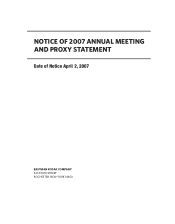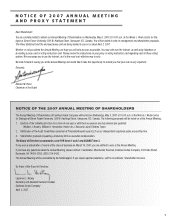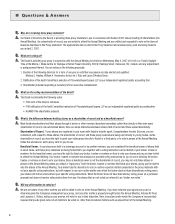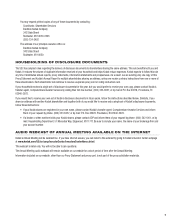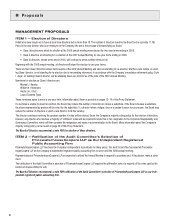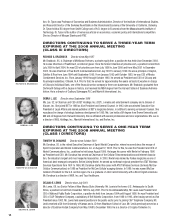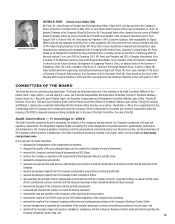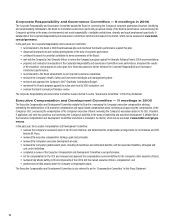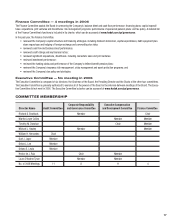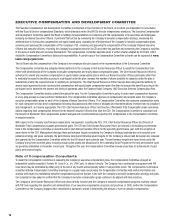Kodak 2006 Annual Report Download - page 164
Download and view the complete annual report
Please find page 164 of the 2006 Kodak annual report below. You can navigate through the pages in the report by either clicking on the pages listed below, or by using the keyword search tool below to find specific information within the annual report.
9
SHAREHOLDER PROPOSAL
ITEM 3 — Shareholder Proposal Requesting A Monetary Limit on
Executive Compensation
Robert D. Morse, owner of over $2,000 in Company stock, submitted the following proposal:
“PROPOSAL: I, Robert D. Morse, of 212 Highland Avenue, Moorestown, NJ 08057-2717, owner of $2000.00 or more in Eastman Kodak Company
stock, propose that the remuneration to any of the top fi ve persons named in Management be limited to $500,000.00 per year, plus any nominal
perks. This program is to be applied after any existing programs now in force for options, bonuses, SAR’s, etc., have been completed, and severance
contracts should be discontinued, as they are also a part of remuneration programs.
This proposal does not affect any other personnel in the company and their remuneration programs.
REASONS: The limit of one half million dollars in remuneration is far above that needed to enjoy an elegant life-style.
Throughout Corporate history, only a few persons whom have created a corporation now remain in Management. Some descendents have inherited
top positions, while most have attained them through recommendations, ability, or infl uence, not necessarily providing increased earnings for a com-
pany. These come from the product or services, its public acceptance, advertising and the workforce.
Due to an unfair removal of the word: “Against” since about Year 1975, and ONLY in the “Vote for Directors” column, Management nominees for that
position are rarely defeated, as receiving only as little as one vote guarantees election, and in turn, Directors re-elect management and reward them.
The term was devised and incorporated in 6 or 8 states of high company registrations as a state and corporate “Rule”. “Right of Dissent” is denied,
and shareowners may not vote “No” or “Against” and be counted as such. This unfairness has yet to be corrected by the Commission as requested.
The Ford Motor Company reinstated “Against” several years ago, showing the American Way of proper corporate proxies presentations. Exxon-Mobil
has reverted to a majority vote for election of Directors., a fi ne decision for shareowners!
Thank you, and please vote “YES” for this Proposal. It is for YOUR benefi t!”
BOARD OF DIRECTORS’ POSITION
Our Board recommends a vote AGAINST this proposal because limiting executive offi cer compensation to $500,000 per year would not be in the best
interests of the Company or you for the following reasons:
Hinders Ability to Attract and Retain Leadership. Attracting and retaining qualifi ed senior leadership and motivating them to contribute to the
success of Kodak depends in part on our ability to remain competitive with companies against which we compete for executive talent. The proposal
would place an arbitrary annual limit on the amount of compensation that can be paid to our senior leadership. Because the market for executive talent
has valued the services of certain senior executives in excess of this limit, the proposal would place the Company at a competitive disadvantage and
severely hinder its ability to recruit and retain talented executive leadership. Our Board believes that it is important that executive compensation be
market competitive. Our executive compensation philosophy provides that total direct compensation, consisting of annual pay, annual variable pay and
long-term variable equity incentives, should be at a competitive median level.
Limits Compensation Committee’s Flexibility. The Executive Compensation and Development Committee (Compensation Committee) of our
Board is composed solely of independent directors and retains an independent external compensation consultant to advise it on executive compensa-
tion matters. The Compensation Committee exercises its business judgment by regularly considering its approach to the compensation paid to the
Company’s senior executives. For example, in 2005, the Compensation Committee, in light of the Company’s extraordinary digital transformation,
requested its independent external consultant to analyze the market competitiveness of each element of compensation paid to the Company’s execu-
tive offi cers. In accordance with the consultant’s recommendation, the Compensation Committee has taken steps to close the competitive defi cits in
long-term compensation for our senior executives while at the same time recognizing the need to constrain cash compensation. The proposal would
impair the Compensation Committee’s ability to exercise this sort of business judgment to account for changes in our Company’s needs, competitive
market conditions and best practices.
Compensation Paid to Senior Executives is Appropriate and Competitive. We believe that the compensation paid to our senior leadership is ap-
propriate and market competitive. Our executive compensation philosophy specifi cally provides that total direct compensation should be at a competi-
tive median level. In addition, our Compensation Committee has put a number of measures in place to ensure that the compensation paid to our senior
offi cers is not excessive. For example, the Compensation Committee regularly meets with its own external independent compensation consultant to
discuss both the reasonableness and competitiveness of the compensation paid to our senior leadership. In addition, the total direct compensation of
our senior offi cers is annually compared to national surveys using companies with gross revenues similar to Kodak’s.
Hinders Compensation Committee’s Duties. Our Compensation Committee is required by the New York Stock Exchange (NYSE) rules and the
Compensation Committee’s charter to review and approve corporate goals and objectives relevant to CEO compensation, to evaluate the CEO’s per-


